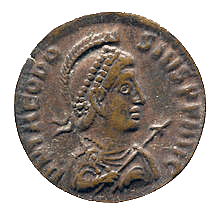Below, an abridged translation from the first volume of Karlheinz Deschner’s Kriminalgeschichte des Christentums (Criminal History of Christianity). For a comprehensive text that explains the absolute need to destroy Judeo-Christianity, see here. In a nutshell, any white person who worships the god of the Jews is, ultimately, ethnosuicidal.
The Emperor Theodosius ‘the Great’
Theodosius I (reign 379-395) found in the father of the Church, Ambrose, an energetic travelling companion. ‘There is hardly a year of his reign’, says the Protestant theologian Von Campenhausen, ‘that he does not proclaim a new law or other measures to fight against paganism [Note of the translator: Hellenism] and to suppress heresy and to favour the Catholic Church’. ‘The annihilation of those who thought differently was, from the beginning, the goal of his government, and the ecclesiastical tradition, which describes Theodosius as an indefatigable protector of Catholicism and an enemy of all heresies and paganism [Hellenism], has portrayed him with complete fidelity’.

(Above, a Nummus of Theodosius.) However, the special merit of the Catholic sovereign consisted in a new policy towards the Germans. In his reorganization of the army, seriously severed, he incorporated ‘barbarians’ (they followed a trend that existed since Constantine) even in the leadership: Franks, Alemanni, Saxons and especially Goths, and with this ‘Gothfied’ army he cleansed the Balkans of Goths, that although officially they belonged to the Empire were not citizens but servants. In his first year of reign, he thus won victories over the Goths, the Alans, and the Huns.
Theodosius, as they always say full of ‘magnanimity towards the vanquished’ (Thiess), ‘the last great protector of the Germans on the Roman imperial throne’ (von Stauffenberg), never fought battles following every rule. Following Valens’ hunting of Gothic heads, he carried out a kind of guerrilla warfare, for which he sacrificed ‘unscrupulously or intentionally’ also the Gothic troops themselves (Aubin). The same as Gratian, he sought to annihilate one after another the various groups of ‘barbarians’.
Thus, he attacked isolated Goth contingents where he thought fit, as for example in 386 a troop of Ostrogoths led by Prince Odotheus. In autumn, they had requested permission to cross the river at the mouth of the Danube, although at first Promotus, the Magister militum that ruled Thrace, denied it. However, a dark night drew them to the river to fall into the hands of the Roman army. They set out to cross it with three thousand boats—the river was full of corpses—and were immediately defeated, while the women and children were left in captivity. However, surely the emperor’s Goth policy would have been different if he had had enough strength.
Theodosius hurried to celebrate the feat and on October 12, with his chariot drawn by elephants (a gift of the Persian king), entered triumphantly in Constantinople, where he had a commemorative column of 40 meters high in memory of this and other massacres of ‘barbarians’. Some years later, his general Stilicho caused a serious setback to another group of Goths. Bishop Theodoret informs with joy about ‘killings’ with ‘many thousands’ of ‘barbarians’ massacred. On the other hand, the prisoners of such operations flooded the slave markets throughout the East.
And from then on, thanks to the ‘merits’ of Theodosius, in all the battles of the invasion of the barbarians there are Germans fighting on both sides.
______ 卐 ______
Liked it? Take a second to support The West’s Darkest Hour.